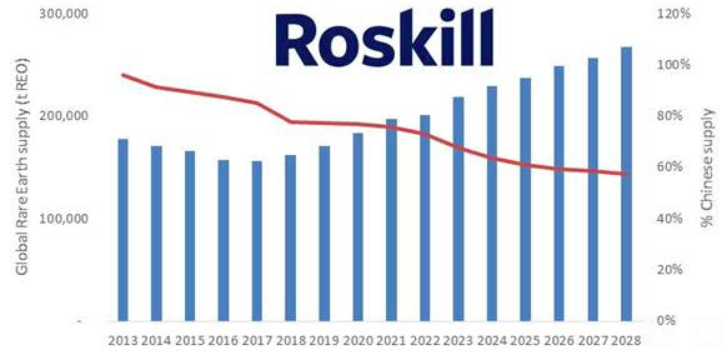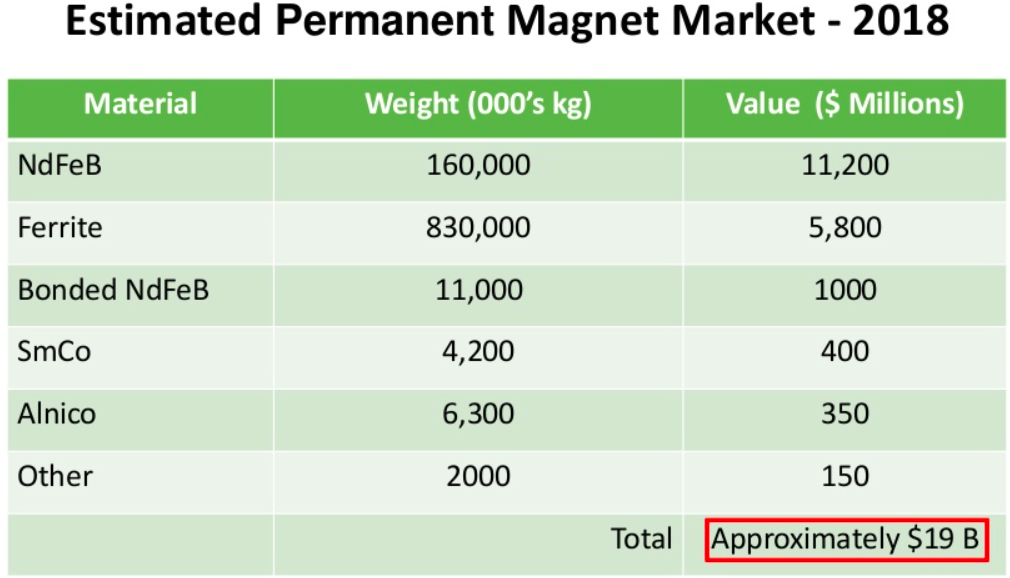The following interview was conducted by email over the past month, as the Rare Earth Elements (“REEs“) expert that I interviewed, David Merriman from Roskill, was traveling. David graduated from the University of Birmingham with a BSc in Geology before completing an MSc in Mining Geology at the Camborne School of Mines (University of Exeter). Prior to joining Roskill, he worked as an exploration geologist on precious metal & REE projects in South America & Africa. Since joining Roskill in 2011, Mr. Merriman has focused on the supply of REEs, lithium & tungsten, undertaking bespoke consultancy projects and contributing to Roskill’s Market Outlook reports. He presents at various conferences in Europe, Asia, Africa & North America on the REE & lithium markets.
Peter Epstein & Epstein Research have no prior or existing relationship with David Merriman, Roskill or any company mentioned in the following interview.
First off, some information from Roskill’s website, “China remains the global leader in the production of both mined rare earth products and refined rare earth compounds, with Chinese production accounting for 86% of global refined production in 2017.” And, “Rare earth production at operations outside China is forecast to increase significantly in the years to 2028, as existing producers expand production capacity and numerous projects in Australia, Russia, the Americas and Africa are scheduled to be commissioned.”

The chart above shows China’s recent past, and future dominance of the global REE sector. The red line represents the % of global supply controlled by China. Just one more quote, “Demand for rare earth permanent magnets is forecast to show strong growth in the years to 2028, which is expected to further distort rare earth demand ratios with Neodymium, Praseodymium & Dysprosium forming a greater proportion of total demand.” Roskill and David Merriman really know their stuff! I asked David about Roskill’s views on the Rare Earths market and got some very interesting, and some surprising answers. Please continue reading to learn more.
In 1 or 2 paragraphs, please tell us what Rare Earth Elements (“REEs”) are, and the most important things for readers to understand about them?
The Rare Earth Elements (“REEs“) are a suite of 15 elements which form the Lanthanide group, ranging from Lanthanum to Lutetium & Yttrium. Naturally occurring together, ores extracted always contain a cocktail of REEs with the relative concentrations being largely dependent upon ore mineralogy and the geological environment.
REEs are used in a very diverse range of applications, from phosphors in lighting, stabilisers in ceramics, catalysts for cracking petroleum products and permanent magnets for windmills & military applications. These applications however almost always require only a select few REEs in their separated form, with other REEs often being detrimental to the performance of a product.

For example, Neodymium, Dysprosium & Praseodymium are used in the production of permanent magnet alloys, though the introduction of Lanthanum & Cerium to these alloys significantly impacts their performance. As a result, the suite of REEs must be separated into smaller groups or individual elements before they may be consumed by end users.
From an investor’s point of view, what’s the difference between Light & Heavy REEs?
From an investor standpoint, the difference between light & heavy REEs provides an indication of the relative concentrations within a deposit. LREE projects have comparatively greater concentrations of Lanthanum, Cerium, Praseodymium, Neodymium & Samarium, forming roughly 75%-99% of all contained REEs in a deposit. Deposits with a LREE assemblage are often higher grade in terms of total REE content, with a number of operations targeting LREE deposits in China, Australia, the U.S. & Russia.
HREE projects, though often containing a majority of LREEs, may contain > 40% HREEs, with some examples containing up to 70% HREEs. Whilst heavy rare earth projects typically exhibit lower total rare earth grades, the greater ratio of higher value elements such as Dysprosium, Terbium & Lutetium make them economically attractive. In 2018, all Rare Earth operations in commercial production targeting HREE deposits were located in China, with Northern Minerals in Australia operating a pilot scale facility.
Which REEs does Roskill consider to be critically important? Is there much debate about which REEs are critically important?
Criticality can be viewed in several ways. For REEs, criticality is very much in the eye of the consumer, as phosphor powder manufacturers see the supply of Europium, Terbium & Yttrium as being critical, whilst magnet producers will likely see the supply of Neodymium & Praseodymium as being critical.

Another perspective is to look at regional or national criticality, assessing the dependence of an industry on a single country or region. The REEs market has been dominated by China, both in terms of supply & demand, for over two decades and China is forecast to remain a dominant supplier of REEs to the global market.
China’s dominant position in the REEs market, the dependence of major economies on imports of Chinese REE products and China’s use of REEs as a political weapon in the past, mean that REEs often top regional criticality studies in the U.S., EU & Japan.
How serious is the current situation between the U.S. & China as it pertains to REEs?
The situation between the U.S. & China with regards to REEs is one sided, with China holding almost all the cards. Over the past 20-30 years the U.S. has slowly sold-off or relocated key REE industries to China, in pursuit of cheaper labor, raw materials, energy and less stringent operating conditions. China’s dominance of the industry is clear, and the U.S. remains susceptible to Chinese policy on production & exports of REEs, though it is considered unlikely that China will restrict supply of REEs to the U.S. as they did to Japan in 2010.
The U.S. lacks a domestic supply chain for certain products such as REE permanent magnets & phosphors used in military applications, but also in major markets like the automotive & electronics industries. Whilst the U.S. does have an operating REE mine at Mountain Pass in California, there is no capacity to process material beyond a mineral concentrate, though a metallurgical plant is currently being renovated.
Even if the Mountain Pass operation or another REE producer based in the U.S. were to produce a separated REE product, the lack of a domestic downstream supply-chain in the U.S. means there would be few domestic customers. REE products would likely be exported from the U.S., with China the most likely destination.
Has Roskill modeled forward CAGRs on the critical REEs?
I will assume the suite of REEs used in permanent magnets to be deemed ‘critical’ as this is expected to be the highest demand growth area. Growth for Neodymium oxide is forecast to be 5.6%/yr. between 2018 & 2028, with Praseodymium at 7.2%/yr. and Dysprosium at 11.6%/yr. Though wind turbines & energy generation are expected to be strong growth areas, the growth in automotive applications is expected to dwarf this demand growth. Below is a slide from one of our presentations showing the relative growth in NdFeB demand through to 2029 by application.

In comparison, the growth in demand for Lanthanum is forecast to be 1.7%/yr. and Cerium 2.9%/yr. in the years to 2028. These are mainly used in ceramics & catalyst applications following more macroeconomic trends, though some cerium ‘replacement’ of Neodymium is being under taken in magnet alloys. Samarium demand is expected to display growth of just under 3%/yr. through 2030, which is comparatively low for the suite of rare earths. The increased use of Lutetium in phosphors & sensors is expected to create strong demand growth, in excess of 8.5%/yr., though demand growth is starting from a low base.
Which 2 or 3 critically important REEs have the most risk of becoming way undersupplied, nearly impossible to obtain, in coming years?
Neodymium & Dysprosium are the only REEs where we forecast supply to become tight in the years to 2030, because of their use in high performance magnets required for the drive trains of hybrid & EVs. We expect the supply-demand dynamics of Neodymium to control the REEs market, as producers look to target/maximise their Neodymium output, with other REEs becoming by-products and entering significant supply surplus.
Does Roskill have forward price forecasts for the critically important REEs? Can you give readers an idea of what Roskill expects?
We expect to see REE prices become increasingly sensitive to the supply and demand of Neodymium oxide (Nd) and Neodymium-Praseodymium (Nd-Pr) oxide. Roskill forecasts real prices for Nd & Nd-Pr to increase by ~15%/yr. in the 3 years to 2021, as supply remains tight, with prices peaking in 2022. A correction period in 2023 & 2024 is expected, followed by annual average real prices breaking the 2022 peak in 2025.
What does Roskill think about the prospects for REE supply coming out of North America?
North America has great potential to become a significant producer of REEs, though a downstream supply chain is required to capture extracted and processed REE products and stop the almost inevitable export to the Chinese market. This will require significant investment, with a chicken and egg situation forming on whether downstream or upstream capacity should be supported first.
What’s a potential surprise in the REE world that few would see coming?
Potential surprises could include further set-backs for Lynas Corporation in Australia, the second largest REE producer and largest non-Chinese producer, after changes to their operating licence renewal conditions by the Malaysian government in December 2018.
What do investors routinely get wrong about the REE sector?
REEs should be viewed as a chemicals industry, not a mining & metals industry. The processing and separation of REEs from ores is complex & costly, with technical knowledge outside of China being limited. Unlike copper or gold there is no centralized market for REEs, with prices negotiated between producers & consumers. As a result, the payability of REE products can range significantly, depending on the purity, grade, form and short-term demand trends for REE products.
Thank you David and Roskill for this informative review of the Rare Earth market.
![Epstein Research [ER]](http://EpsteinResearch.com/wp-content/uploads/2015/03/logo-ER.jpg)





